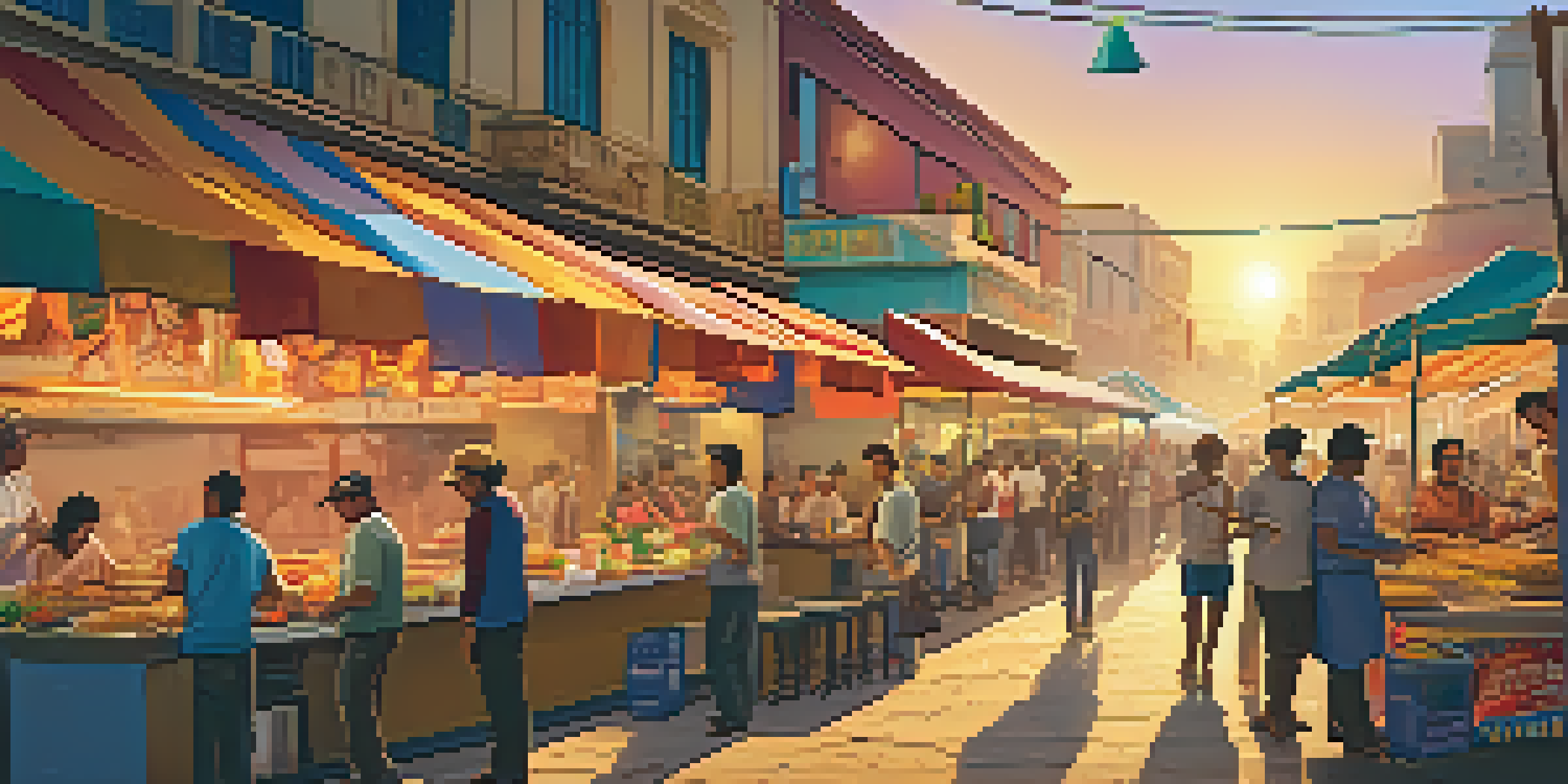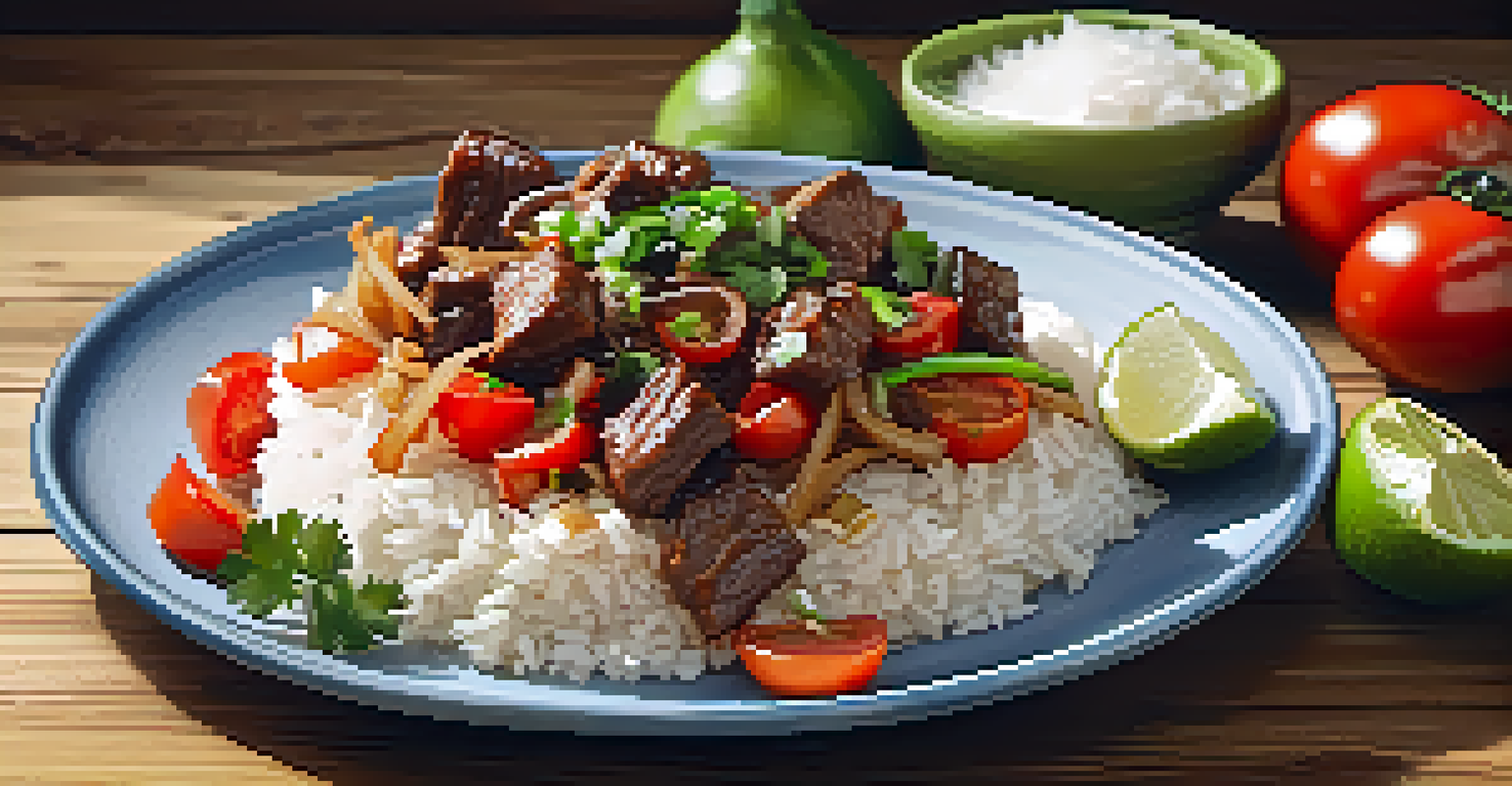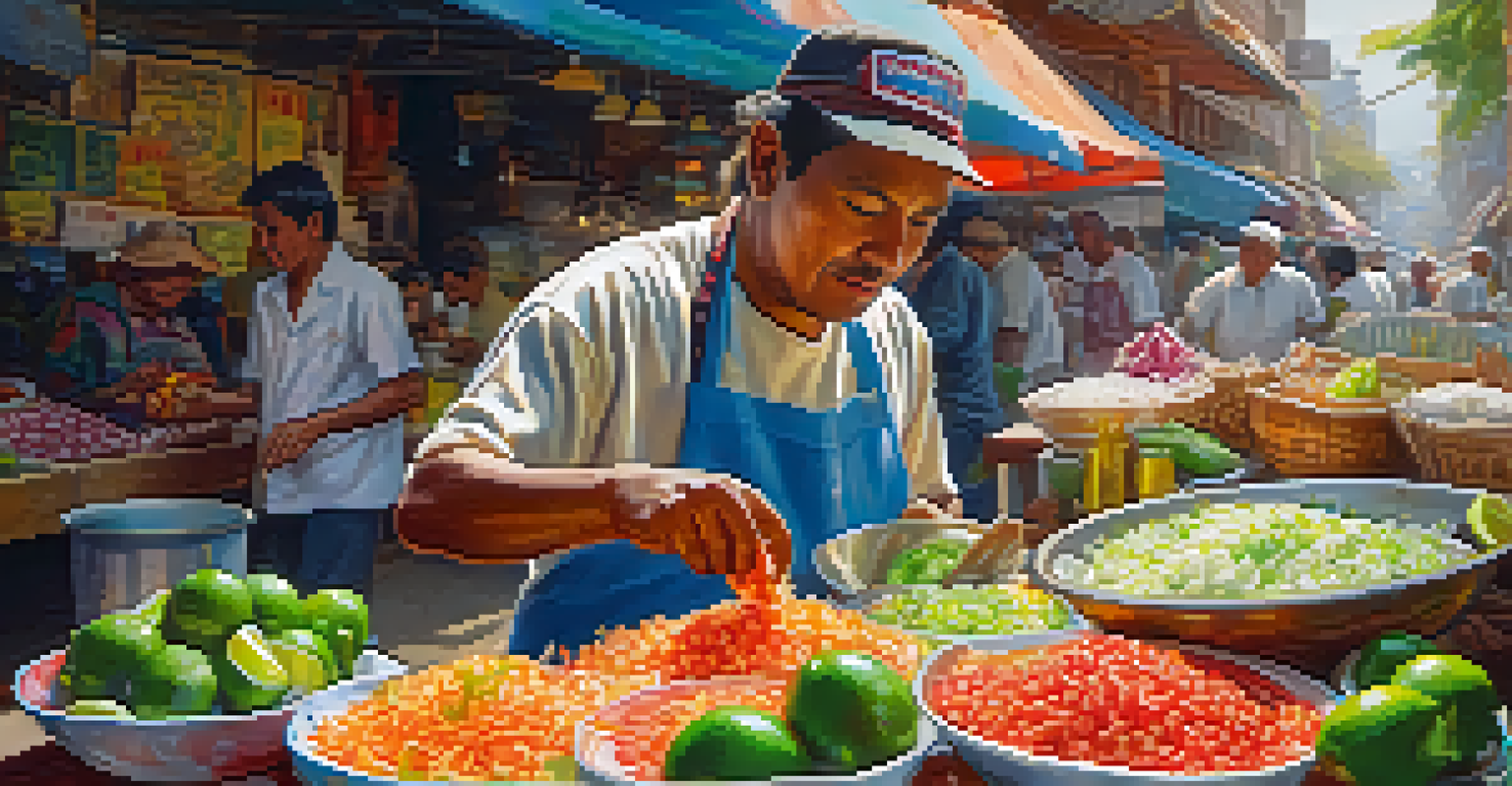The Impact of Peruvian Street Food on Global Food Trends

What Makes Peruvian Street Food Unique and Flavorful
Peruvian street food is a vibrant reflection of the country’s diverse cultures and traditions. With influences from Indigenous, Spanish, African, and Asian cuisines, each dish tells a story of migration and adaptation. For instance, the beloved ceviche highlights the fresh, local seafood, combined with zesty lime and aromatic herbs, making it a staple at street vendors.
Food is an important part of a balanced diet.
The use of native ingredients like aji peppers and potatoes, which come in hundreds of varieties, adds a unique twist to common dishes, enhancing their flavors and textures. Street vendors often take pride in their recipes, passed down through generations, ensuring that each bite carries a sense of authenticity. This rich tapestry of flavors makes Peruvian street food stand out in the global culinary scene.
As food lovers seek out authentic experiences, Peruvian street food offers a delicious gateway into the country’s culture. From the bright, zesty flavors of aji de gallina to the heartiness of anticuchos, there’s something for everyone to enjoy. This authenticity resonates with diners, making Peruvian cuisine not just a meal, but an experience.
The Rise of Peruvian Cuisine in International Markets
In recent years, Peruvian cuisine has gained significant traction in international markets, thanks to the growing popularity of its street food. Restaurants featuring these dishes have opened in cities worldwide, attracting food enthusiasts eager to try something new. This surge can be attributed to renowned chefs like Gastón Acurio, who has championed Peruvian flavors globally.

Social media also plays a pivotal role in this rise, with food bloggers and influencers showcasing vibrant dishes like lomo saltado and causa. The visually appealing nature of these meals makes them perfect for platforms like Instagram, where food can be both a feast for the eyes and the palate. This visibility helps Peruvian street food gain recognition and popularity beyond its borders.
Cultural Richness in Every Bite
Peruvian street food reflects a vibrant tapestry of diverse cultural influences, showcasing authentic flavors and traditions in each dish.
Moreover, culinary festivals and events celebrating Peruvian cuisine have popped up globally, allowing chefs and food lovers to come together. These gatherings not only highlight the dishes but also promote a deeper understanding of the culture behind them. As more people experience these flavors, the influence of Peruvian street food continues to expand.
How Peruvian Street Food Inspires Global Culinary Trends
Peruvian street food has sparked numerous culinary trends that resonate with chefs and home cooks alike. One notable trend is the incorporation of fresh, local ingredients and bold flavors, encouraging a move away from processed foods. Dishes like ceviche have inspired a wave of fresh seafood preparations in various culinary contexts.
The food you eat can be either the safest and most powerful form of medicine or the slowest form of poison.
Additionally, the fusion of different cuisines seen in Peruvian street food encourages experimentation in kitchens around the world. For instance, the blend of Asian and Peruvian flavors in dishes like sushi ceviche showcases how cultural borders can blur in the culinary world. This fusion trend invites creativity and innovation, leading to exciting new dishes.
As a result, many restaurants are now featuring menu items that reflect this global influence, often drawing inspiration from traditional Peruvian recipes. This not only diversifies their offerings but also appeals to a growing customer base interested in unique dining experiences. Through these adaptations, Peruvian street food continues to leave its mark on global culinary practices.
The Role of Social Media in Promoting Peruvian Street Food
Social media has become a powerful tool in promoting and popularizing Peruvian street food around the globe. Platforms like Instagram and TikTok allow street vendors and chefs to showcase their dishes visually, attracting attention from food enthusiasts. Stunning images of colorful plates and mouth-watering preparation processes draw viewers in, making them eager to try these flavors for themselves.
Food influencers play a crucial role as well, sharing their experiences and recommendations, which can lead to increased foot traffic for local vendors. Their posts often highlight not just the food, but the vibrant atmosphere of street markets, creating a sense of community and culture. This shared content helps elevate Peruvian cuisine on a global scale.
Social Media Boosts Global Exposure
Platforms like Instagram and TikTok play a crucial role in promoting Peruvian street food, helping to elevate its profile and attract food enthusiasts worldwide.
Moreover, viral food trends, such as the 'ceviche challenge,' encourage users to recreate dishes at home, further spreading awareness. This interactive engagement allows people to connect with Peruvian cuisine in a personal way. As a result, social media not only entertains but also educates, making Peruvian street food a significant player in the global culinary landscape.
The Cultural Significance of Peruvian Street Food
Peruvian street food is not just about eating; it embodies cultural identity and heritage. Each dish reflects the history and traditions of the people, showcasing the flavors of the land and its resources. For example, anticuchos, or skewered beef hearts, have roots in pre-Columbian times and have evolved into a beloved street food that connects generations.
Moreover, street food vendors often serve as vital community hubs, bringing people together over shared meals and experiences. These gatherings create a sense of belonging and provide a platform for local traditions to thrive. In this way, street food is a celebration of community, culture, and shared stories.
As Peruvian street food gains recognition worldwide, it fosters a greater appreciation for its cultural significance. This not only promotes culinary diversity but also encourages respect for the traditions behind the food. Ultimately, enjoying Peruvian street food is a way to engage with its rich cultural narrative.
Challenges Faced by Peruvian Street Food Vendors
Despite its growing popularity, Peruvian street food vendors face various challenges that can impact their livelihoods. Regulatory hurdles, such as obtaining permits and health inspections, can be daunting for small business owners. These obstacles can deter aspiring vendors from entering the market, limiting the diversity of voices in the street food scene.
Additionally, economic fluctuations and competition from larger restaurants can make it difficult for vendors to thrive. Many rely on loyal customers who appreciate their authentic offerings, but attracting new clientele can be a constant struggle. This is especially true in urban areas where food trends shift rapidly, making it crucial for vendors to stay relevant.
Challenges for Street Food Vendors
Despite its popularity, Peruvian street food vendors face significant challenges, including regulatory hurdles and economic pressures, which affect their ability to thrive.
Moreover, the COVID-19 pandemic has highlighted the vulnerabilities of street food businesses, with many facing temporary closures or reduced foot traffic. However, some have adapted by utilizing delivery services and social media to reach customers. These challenges serve as a reminder of the resilience and creativity that define the spirit of Peruvian street food vendors.
The Future of Peruvian Street Food on the Global Stage
As global interest in diverse cuisines continues to grow, the future of Peruvian street food looks promising. With its rich flavors and cultural significance, it is poised to make even deeper inroads into the culinary world. Chefs are increasingly incorporating traditional recipes into modern dining experiences, further elevating its status.
The fusion of Peruvian street food with other culinary styles also opens new avenues for innovation. Chefs can experiment with combinations that appeal to global palates, creating exciting new dishes that maintain the essence of Peruvian flavors. This adaptability will help keep Peruvian cuisine relevant in an ever-changing food landscape.

Moreover, awareness of sustainable practices and local sourcing will likely become a focal point for street food vendors. As consumers increasingly prioritize ethics in their food choices, vendors who embrace these values will resonate with their audience. In this way, Peruvian street food stands not just as a trend but as a lasting influence on the global culinary stage.